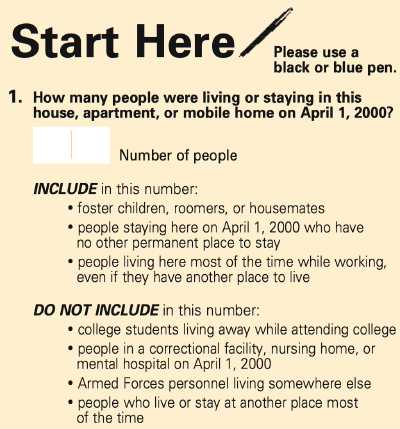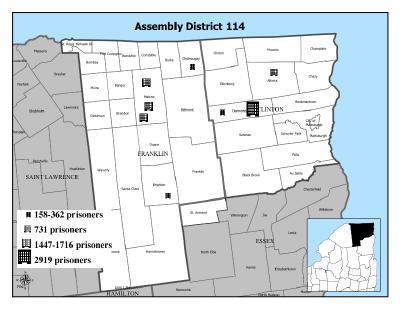by Peter Wagner,
December 29, 2003
New prisons in Illinois are being built further and further from urban Chicago, home to 59% of the state’s prisoners. Prior to 1980, the average prison was 160 miles from the city. Prisons built in the 1980s were an average of almost 220 miles and prisons built in the last decade averaged 260 miles from Chicago.
Because the Census counted 45,000 Illinois prisoners not at home but in their rural prison cells, political power is flowing out of Chicago into increasingly more distant prison towns.
Sources:
IL DOC Statistics
Paul Street, and Dennis Kass, The Color and Geography of Prison Growth in Illinois [PDF],. Chicago Urban League, page 2.
by Peter Wagner,
December 27, 2003
Pamela S. Karlan of Stanford Law School has a great new article about felon disenfranchisement that discusses the census issue:
The year 2000 involved another event that highlighted the racially salient political consequences of the war on crime and its attendant disenfranchisement of large numbers of minority citizens. Under the “usual residence rule,” the Census Bureau counts incarcerated individuals as residents of the jurisdiction in which they are incarcerated. In many states, this results in largely white, rural communities having their population totals increased at the expense of the heavily urban, overwhelmingly minority communities from which most inmates come. This reallocation of population has at least two important effects. First, because a substantial amount of federal and state aid to localities is based on population, heavily minority communities lose revenue: Chicago, for example, stands to lose $88 million over the next decade because roughly 26,000 Chicagoans, 78 percent of them black, were serving time in downstate prisons at the time of the 2000 census. Second, because electoral districts are also based on population, people in prison serve as essentially inert ballast in the redistricting process. They enable the underpopulation of rural, overwhelmingly white districts relative to urban, heavily minority ones, thereby potentially changing the overall composition of legislative bodies. For example, in New York State, seven conservative upstate Republicans represent state senatorial districts that comply with one-person, onevote only because incarcerated prisoners are included within the population base. But these officials are neither descriptively nor substantively “representative” of their inmate “constituents.” As a result, many commentators have compared the inclusion of incarcerated inmates in the population base of the jurisdictions where they are incarcerated to the notorious “three fifhs” clause in the original Constitution, which enhanced the political clout of slave-holding states by including slaves in the population base for calculating congressional seats and electoral votes.
Pamela S. Karlan, Convictions and doubts: Retribution, representation, and the debate over felon disenfranchisement (Internal citations omitted) Stanford Law School
by Peter Wagner,
December 22, 2003
Unlike the other populations in other Census controversies (college students and military personnel) prisoners are not considered a part of the local community. After release, the incarcerating community no doubt wishes that ex-prisoners would leave on the first bus out of town.
The Census should allow prisoners to provide their own addresses, or it could use the “home of record” on file with the Department of Corrections. Using “home of record” to address special Census populations is not new. When at the last minute the 1990 Census decided to count military personnel stationed abroad as residents of individual states, they used the Department of Defenses’ home of record information despite the fact that this information tended to be outdated and biased towards the income tax laws of New Hampshire.
The Supreme Court upheld the Census’s use of “home of record” for military personnel abroad in the 1990 Census in Franklin v. Massachusetts 505 U.S. 788 (1992).
by Peter Wagner,
December 15, 2003
The Census counts prisoners as if they were residents of the prison town, but if prisoners could vote, they would vote at home. This isn’t just a matter of choice, it’s one of law.
Two states (Vermont and Maine) let prisoners vote and, until recently, two additional states (Utah and Massachusetts) did as well. Most prisoners didn’t vote, but when they did, each state required prisoners to vote not at the prison, but at home. An examination of how the four states required prisoners to vote at home is illustrative of how the question of prisoner residence should be treated for purposes of redistricting and representation.
Continue reading →
by Peter Wagner,
December 8, 2003

The 2000 Census form says to exclude family members incarcerated in correctional facilities.
While the Census’ usual residence rule has evolved over time, some “group quarters” populations such as nursing home residents, prisoners and those inside mental hospitals have, at least since 1850, always been counted at the facility. Whether the local count also excluded these populations — especially that of prisoners — is open to question.
Continue reading →
by Peter Wagner,
December 1, 2003
The inmates at Attica prison in western New York state are represented in Albany by state Sen. Dale Volker, a conservative Republican who says it’s a good thing his captive constituents can’t vote, because if they could, “They would never vote for me.” …
Senator Volker made his career pushing prison expansion and the criminalization of drug use. He calls himself the “Keeper of the Keys” for his control of where new prisons are built. Because the U.S. Census counts prisoners where they are incarcerated, Volker gets to include the prisoners when redrawing his district lines each decade to ensure that he has the same population as other districts. Equal-sized districts are necessary to ensure that all citizens have an equally weighted vote.
Continue reading →
by Peter Wagner,
November 24, 2003
Counting urban prisoners as rural residents turns the entire idea that districts should be of equal population on its head. In three New York Senate districts, and 10 Assembly districts, at least 2% of the “constituents” are prisoners. The district of upstate Republican Chris Ortloff has the highest percentage of prisoners in the legislature: 6.99%.
The population to be “represented” by Assemblyman Ortloff includes 5,594 Black adults, 82.6% of who are barred by law from ever voting for or against him. By the time these prisoners complete their sentences and are again allowed to vote, they will be back home in a different district.
The prisoners should never have been counted locally for the same reason vacationers are not counted locally: they are only there temporarily.
Importing Constituents: Prisoners and Political Clout in New York
How prison counts change district lines. A graphical explanation using Assemblyman Chris Otloff’s district 114 as the example
by Peter Wagner,
November 17, 2003
The experience in Kansas shows that it is practical to adjust the Census data to reflect state residents at their home, rather than Census, addresses. If the federal Census does not change how it counts special populations, it is not necessary for a state to entirely abandon the federal census. Kansas switched from its own state census to the federal census with one exception: Kansas does a special census of students and military personnel so it can change how they are counted in the data used for redistricting. Expanding this practice to prisoners should be quite simple.
The Kansas Constitution requires that redistricting be based on Census data adjusted to:
- exclude non-resident students and military personnel and
- transfer in-state students and military personnel back to their home addresses elsewhere in Kansas.
by Peter Wagner,
November 10, 2003
While states must redistrict on the basis of actual population, the U.S. Constitution does not require states to use the federal census for its own redistricting:
“Although a state is entitled to the number of representatives in the House of Representatives as determined by the federal census, it is not required to use these census figures as a basis for apportioning its own legislature.”
States are therefore free to use their own census or to correct how the federal census counts prisoners.
Bethel Park v. Stans, 449 F.2d 575, 583 (3rd Cir. 1971)
by Peter Wagner,
November 3, 2003
The Census cites its “usual residence rule” as requiring it to count prisoners at the prison. That’s true as far as it goes in regards to prisoners, but the Census and Congress have the power to change this rule, doing so for college students in the 1950s and for military personnel and other groups many times since 1900. Currently, college students living at the college are counted at the college, but prior to the 1950 Census, they were counted at their parent’s home. (Boarding school students younger than college age are still counted at home.)
The Census has been even more inconsistent with overseas military:
With the exception of the 1900 census, the Bureau only began to count overseas military personnel in 1970, allocating them to … their “home of record,” namely the state to which they declared they would return at the end of their service. In 1980, … the Bureau ceased allocating overseas federal employees to particular states. However, the federal employees still considered themselves to be “usual residents” of the United States, and for that reason, among others, the Bureau again reversed its policy in 1990 and allocated federal employees living overseas according to their “home of record.”
The counting of overseas missionaries from the Church of Latter-Day Saints (Mormons) and applying them back to their home states has likewise been changed, counting the missionaries from 1910 to 1940 but not before or after.
The usual residence rule is not an inflexible constitutional mandate. It is a rule within the power of Congress and the Census to modify based on new situations and needs. The usual residence rule should be modified once again so that the Census can more accurately count our nation’s large and growing prison population where they truly reside: with their home communities.
Franklin v. Massachusetts 505 U.S. 788 (1992). Second Amended Complaint, Utah v Evans, Utah D.C. paragraph 32.





